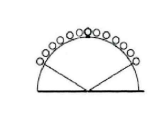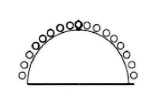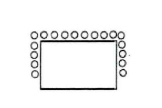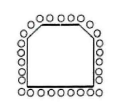Common Types and Layout Form of Pipe Roof
Time:2024-05-09From:sinorock View:
I. Introduction
Pipe roofs play a crucial role in stabilizing tunnels and underground structures, particularly in areas with weak and broken surrounding rock. TProper selection and design of pipe roofs ensure structural integrity, safety, and efficiency in tunnel construction.
This article aims to provide insights into the common types and layout forms of pipe roofs, as well as factors influencing their selection. By exploring these aspects, we hope to better understand pipe roofing systems and their applications in different geological and environmental conditions.
II. Understanding Pipe Roofs
A. Definition and basic components
Pipe roofs consist of steel pipes driven into the surrounding stratum, forming a shed frame in combination with steel arch frames. The basic components include steel pipes, grouting materials (if applicable), and supplementary support structures.
B. Functionality and advantages
Pipe roofs serve multiple functions, including stabilizing excavation surfaces, reinforcing weak surrounding rock, and distributing overlying loads. Their advantages include enhanced tunnel stability, prevention of stratum collapse, and improved construction progress.
C. Applications in various industries
Pipe roofs find applications in various industries such as highway and railway tunnels, subway systems, hydropower stations, and other underground projects. They are particularly suitable for soft and broken surrounding rock conditions.
III. Common Types of Pipe Roofs
A. Classified by construction method
The construction method of the pipe roof is classified according to the different ways of driving the steel pipe into the soil.
a. The Drilling method is a widely used method. It mainly uses a drilling machine to form holes, and then pushes the steel pipes one by one. In actual situations, problems such as hole collapse and pipe sticking may occur. Drilling and pipe inserting is carried out at the same time.
b. The Rammed Pipe method is mainly used in some soft soils, and the steel pipe is directly rammed into the soil through some tools to form a pipe roof.
c. The Pipe Jacking method is to directly push the steel pipe into the stratum through the jacking technology to achieve the purpose of installing the pipe roof.
B. Classified by steel pipe layers
The pipe roof can be divided according to the number of layers of steel pipe arrangement. There are single-layer and double-layer pipe roofs.
When the overlying load of the tunnel is not large, in order to reduce unnecessary waste of pipes, the single-layer pipe roof is often used.
If the tunnel is located in a complex condition, or the overlying load is relatively large, double-layer pipe roofs can be used.
In the actual situation, combined with the characteristics of the project, double-layer pipe roofs can be selectively set up in some weak parts, and single-layer pipe roofs can still be used in other parts with sufficient bearing capacity.
C. Classified by the length of steel pipes
Short pipe roof: Pipe roof with a length of single circulating steel pipe less than 6m.
Long pipe roof: Pipe roof with a length of single circulating steel pipe more than 6m.
D. Classified by the diameter of the steel pipes
The pipe roofs can be divided into three categories according to the different diameters:
Small pipe roofs: steel pipe diameter less than 129mm;
Large pipe roofs: steel pipe diameter greater than 300mm;
Middle pipe roof: steel pipe diameter between 129~300mm.
In actual engineering, 89mm, 108mm, and 159mm are used more.
E. Classified by grouting or not
a. The pipe roof without grouting:
Only needs to drive the steel pipe into the stratum, without grouting reinforcement of the rock and soil around the tunnel, but only fill the steel pipe, so as to improve the strength performance of the steel pipe. The filler is generally mortar or concrete.
b. The grouting pipe roof can be divided into two types according to the grouting sequence:
(1) First, install the steel pipe in the stratum. After the installation is completed, grouting can be carried out for reinforcement.
(2) First, grouting to the surrounding rock, and then the steel pipe is inserted to ensure the supporting performance and improve the overall bearing capacity.
IV. Layout Forms of Pipe Roofs
The arrangement of the pipe roof is an important part of tunnel construction design. The common arrangement ways are as follows:
A. Fan-shaped distribution
It is mainly used when the surrounding rock condition of the tunnel is relatively good. And the tunnel arch is the weak link of the bearing capacity of the upper part of the tunnel, and the stability of the surrounding rock is poor.

B. Semicircular distribution
It belongs to the expansion form of fan-shaped distribution and is mainly used in the case of unstable upper strata, in order to fully control the displacement of the rock mass.

C. Door-shaped distribution
It is mainly used when the basic level of the surrounding rock is relatively low. During the tunnel excavation process, not only the upper surrounding rock is indifferent, but the surrounding rock displacement on both sides is also relatively large.

D. Whole-circumferential distribution
It is used in the surrounding rock that is weak, broken, expansive and has a lot of groundwater, in order to fully control the stability of the tunnel during construction.

E. Unilateral distribution in the upper half
When the tunnel is located in a sloping terrain and its force is biased, this type of reinforcement is often used.

F. In-line distribution
When the tunnel needs to pass through some railways, highways, or other structures, and the distance is relatively close, this form is often used.

G. Double-layer distribution
When the geological condition of the tunnel is poor and the upper part needs to carry a large load, this form is usually used to control the deformation of the surrounding rock after the tunnel is excavated.

V. Factors Influencing Pipe Roof Selection
A. Environmental Conditions
1. Geological Characteristics: The geological composition of the surrounding rock profoundly influences pipe roof selection. Engineers must consider factors such as rock type, stability, and presence of fault lines or fractures. In stable geological formations, simpler pipe roof designs may suffice, while complex geological conditions may necessitate more robust and versatile pipe roof systems.
2. Water Content: High water content in the surrounding stratum can pose challenges during pipe roof installation and maintenance. Excessive groundwater may weaken the stability of the tunnel excavation surface and compromise the effectiveness of traditional pipe roofs. In such environments, engineers may opt for specialized waterproofing techniques or incorporate grouting into the pipe roof design to enhance water resistance and structural integrity.
3. Soil Stability: The stability of the soil surrounding the tunnel plays a crucial role in pipe roof selection. Soft and loose soil conditions require careful consideration to prevent collapse or deformation during pipe roof installation. Engineers may employ reinforcement techniques such as grouting or choose pipe roof configurations that provide additional support and stability in weak soil conditions.
B. Structural Requirements
1. Tunnel Dimensions: The dimensions of the tunnel, including width, height, and length, influence the design and placement of the pipe roof. Larger tunnels with expansive dimensions may require more robust pipe roof systems capable of bearing heavier loads and spanning greater distances. Engineers must carefully assess tunnel dimensions to ensure that the selected pipe roof configuration meets structural requirements and provides adequate support.
2. Overlying Loads: The magnitude of overlying loads exerted on the tunnel roof dictates the strength and durability requirements of the pipe roof system. Tunnels located beneath highways, railways, or densely populated urban areas may experience significant overburden pressure, necessitating the use of reinforced pipe roof designs or double-layer configurations to distribute loads effectively and minimize deformation.
3. Surrounding Rock Conditions: The condition of the surrounding rock, including its strength, integrity, and susceptibility to erosion or deterioration, influences pipe roof selection. In areas with unstable or fractured rock formations, engineers may opt for pipe roof systems that offer enhanced reinforcement and support to mitigate the risk of rockfall, subsidence, or collapse.
C. Budgetary Constraints
1. Material Costs: The cost of materials, including steel pipes, grouting materials, and supplementary support structures, significantly impacts pipe roof selection. Engineers must balance the performance and durability of pipe roof systems with budgetary constraints to ensure cost-effective solutions without compromising safety or structural integrity.
2. Installation Costs: The complexity of pipe roof installation, including labor, equipment, and associated expenses, affects overall project costs. Engineers may consider alternative construction methods or prefabricated pipe roof systems to streamline installation processes and reduce labor-intensive tasks, thereby optimizing project budgets while maintaining quality and efficiency.
D. Maintenance Considerations
1. Long-Term Durability: The long-term durability and maintenance requirements of pipe roof systems influence selection decisions. Engineers must assess the expected lifespan of pipe roof materials and consider factors such as corrosion resistance, weathering, and structural integrity over time. Durable materials and proactive maintenance practices can minimize the need for costly repairs or replacements and extend the service life of pipe roof systems.
2. Accessibility for Inspection and Maintenance: Ease of access for inspection and maintenance is essential for ensuring the continued effectiveness and safety of pipe roof systems. Engineers should design pipe roofs with provisions for regular inspection, cleaning, and maintenance activities, including access points, drainage channels, and monitoring equipment. Proactive maintenance practices help identify potential issues early and mitigate risks of structural damage or failure.
VI. Conclusion
Pipe roofing is mainly used in tunnel projects with soft and broken surrounding rock, such as highway and railway tunnels, subways, hydropower station tunnels, and other underground projects. Traditional pipe roofs generally are seamless steel pipes. Hole collapse may occur during construction in the weak surrounding rock, which makes it difficult to insert pipe roof, so the casing is required.
Proper selection of pipe roofs enhances tunnel stability, mitigates risks of stratum collapse, and ensures construction progress. The self-drilling pipe roof system consists hollow anchor bar, coupling, and drill bit, which can be drilled and grouted at one time. The self-drilling pipe roof system can replace traditional pipe roofs in a variety of easily collapsed formations, and common specifications are R51, T76, T103, etc. For reliable and efficient pipe roofing solutions, consider self-drilling pipe roofing systems offered by Sinorock. Contact us at sinorock@sinorockco.com to learn more about our products and services.
latest news
-

- What Are the Applications of SDA Bolts in Hydropower Stations?
- Time:2025-08-21From:This Site
- Learn how self-drilling anchor bolts enhance slope stability, tunnel support, and dam reinforcement in complex geological conditions at hydropower stations. Optimize hydropower projects with efficient, cost-effective, and eco-friendly solutions.
- View details
-

- Slope Stabilization with SDA Bolts: Benefits & Applications
- Time:2025-08-19From:This Site
- Discover how self-drilling anchor bolts (SDA bolts) provide superior slope stabilization for highways, railways, and tunnels. Learn their key benefits, installation process, and real-world applications in loose or collapsible soils.
- View details
-

- How Self-Drilling Rock Bolts Enhance Tunnel Support in Fractured Rock?
- Time:2025-08-15From:This Site
- Discover how self-drilling rock bolts enhance tunnel support in fractured rock. Learn their benefits, installation steps, and real-world applications for safe, efficient tunneling.
- View details
-

- Sinorock 2025 Quality Month | Strengthening Quality Foundations, Empowering Product Excellence
- Time:2025-08-13From:This Site
- Sinorock’s 2025 Quality Month, themed “Strengthening Quality Foundations, Empowering Product Excellence,” successfully concluded, reinforcing our commitment to superior product quality.
- View details
-

- Sinorock Safety Month 2025 | Everyone Speaks Safety, Everyone Can Respond
- Time:2025-07-03From:This Site
- Sinorock Safety Month 2025, centered on the theme "Everyone Speaks Safety, Everyone Can Respond - Spot Workplace Hazards," has wrapped up successfully!
- View details
-

- Quality Control: the Vital Factor of A SDA Bolt Factory
- Time:2025-01-09From:This Site
- Sinorock’s comprehensive quality control system, from supplier management to outgoing inspections, ensuring the highest standards for self-drilling anchor bolts in construction.
- View details
-

- Sinorock Invites You to Explore Proven Self-Drilling Anchor Bolt Solutions at bauma 2025
- Time:2025-03-07From:This Site
- From April 7–13, 2025, explore Sinorock’s Self-drilling anchor bolt solution at Booth C2.513/4 in Hall C2 of the Messe München Exhibition Center (Munich, Germany).
- View details
-
.jpg)
- SINOROCK to Attend EXPOMINA PERÚ 2024 in Lima, Peru
- Time:2024-08-10From:This Site
- Sinorock to Attend EXPOMINA PERÚ 2024 in Lima, Peru
- View details
-
.jpg)
- SINOROCK to Participate in MINING AND METALS CENTRAL ASIA 2024
- Time:2024-08-08From:This Site
- SINOROCK to Participate in MINING AND METALS CENTRAL ASIA 2024
- View details
 Download
Download 


